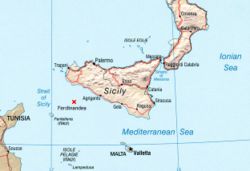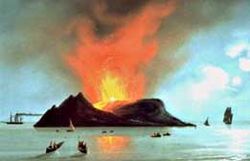Ferdinandea
2008/9 Schools Wikipedia Selection. Related subjects: European Geography
Ferdinandea is a submerged volcanic island that forms part of the newly discovered underwater volcano Empedocles, 30 km south of Sicily. Currently a seamount, eruptions have raised it above sea level several times before erosion has caused it to submerge again. When it last rose above sea level after erupting in 1831, a four-way dispute over its sovereignty began, which was still unresolved when it disappeared beneath the waves again in early 1832. During its brief life, the French geologist Constant Prévost was on hand, accompanied by an artist, to witness it that July; he named it Île Julia, for its July appearance, and reported in the Bulletin de la Société Géologique de France.
History
Ferdinandea lies in a volcanic area known as the Campi Flegrei del Mar di Sicilia (Phlegraean Fields of the Sea of Sicily), which lies between Sicily and Tunisia in the Mediterranean Sea. Many submarine volcanoes ( seamounts) exist in the region, as well as some volcanic islands such as Pantelleria. Volcanic activity at Ferdinandea was first reported in the region during the First Punic War, and the island has appeared and disappeared four or five times. Since the 17th century several eruptions have been reported.
1831 eruption
Ferdinandea's most recent appearance as an island was in July 1831. It was subject to a four-way dispute over its sovereignty, originally being claimed for the United Kingdom and given the name Graham Island. The King of Naples, Ferdinand II, after whom the island was named Ferdinandea, sent ships to the nascent island to claim it for the Bourbon crown, while the French Navy also made a landing and called the island Julia. Spain also declared its territorial ambitions.
The eruptions of 1831 saw the island increase in size to some 4 km². However, it was composed of loose tephra, easily eroded by wave action, and after the end of the eruptive episode it rapidly subsided, disappearing beneath the waves in January 1832, before the issue of its sovereignty could be resolved. Fresh eruptions in 1863 caused the island to reappear briefly before sinking again below sea level.
Recent activity
After 1863 the volcano lay dormant for many decades, with its summit just 8 m below sea level. In 1987, it was allegedly mistaken for a Libyan submarine and bombed by a U.S. Air Force plane on its way to bomb Tripoli.
In 2002, renewed seismic activity around Ferdinandea led volcanologists to speculate that a new eruptive episode could be imminent, and the seamount might once more become an island. To forestall a renewal of the sovereignty disputes, Italian divers planted a flag on the top of the volcano in advance of its expected resurfacing. However, the seismicity did not lead to volcanic eruptions and as of 2006 Ferdinandea's summit remains about six meters below sea level.

